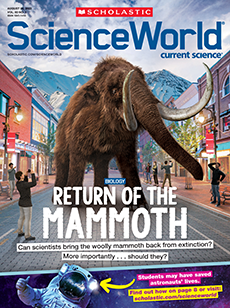JOHN MUGGENBORG/ALAMY STOCK PHOTO
MARSHMALLOWS GALORE: About 2 billion Peeps are produced each year—enough to circle Earth twoand- a-half times!
It’s springtime. That means grocery stores are stocked with an iconic treat: marshmallow Peeps! The sugar-coated chicks were invented more than 70 years ago, followed by bunnies in the 1980s. Today Peeps have been reimagined for other holidays and seasons—ghosts and pumpkins for Halloween, reindeer and snowmen in wintertime, and hearts for Valentine’s Day. Originally just plain marshmallow, Peeps now come in a huge variety of flavors, from cotton candy and sour watermelon to Dr. Pepper and spicy cinnamon!
No matter the taste, all Peeps are made with the same basic ingredients: sugar and corn syrup for sweetness, plus gelatin to give the marshmallows their structure. When these ingredients are mixed, heated, and whipped, this creates “a big, fluffy collection of long gelatin molecules that are all tied together and intertwined,” says Douglas Mulford, a chemist at Emory University in Georgia. This mesh of molecules traps air in the mixture, forming a spongy texture.
The air inside Peeps also makes them perfect for classroom experiments. A teacher might place a Peep in a vacuum chamber. As all the air in the chamber is sucked out, the gas inside the marshmallow has room to spread. The Peep grows to an enormous size—and eventually starts to deflate after all the air has left its squishy body. Something similar happens when a Peep is microwaved. When heated, the air molecules inside the Peep move faster and farther apart. This causes it to expand. Chew on this sweet science the next time you bite into a Peep!
It’s springtime. That means grocery stores are stocked with a famous treat: marshmallow Peeps! The sugar-coated chicks were invented more than 70 years ago. Bunnies followed in the 1980s. Today Peeps have new forms for other holidays and seasons. There are ghosts and pumpkins for Halloween, reindeer and snowmen in wintertime, and hearts for Valentine’s Day. At first, Peeps were just plain marshmallow. They now come in many flavors. You’ll find cotton candy and sour watermelon Peeps, and even Dr. Pepper and spicy cinnamon!
Peeps may have different flavors. But all are made with the same basic ingredients. Sugar and corn syrup make them sweet. And gelatin gives the marshmallows their structure. These ingredients are mixed, heated, and whipped. This creates “a big, fluffy collection of long gelatin molecules that are all tied together and intertwined,” says Douglas Mulford. He’s a chemist at Emory University in Georgia. This mesh of molecules traps air in the mixture to form a spongy texture.
The trapped air also makes Peeps perfect for classroom experiments. A teacher might place a Peep in a vacuum chamber. All the air in the chamber is sucked out. That gives the gas inside the marshmallow room to spread. The Peep grows to an enormous size. After all the air has left its squishy body, it starts to deflate. Something similar happens when a Peep is microwaved. The air molecules inside the Peep heat up. They move faster and farther apart. This causes the Peep to expand. Chew on this sweet science the next time you bite into a Peep!

